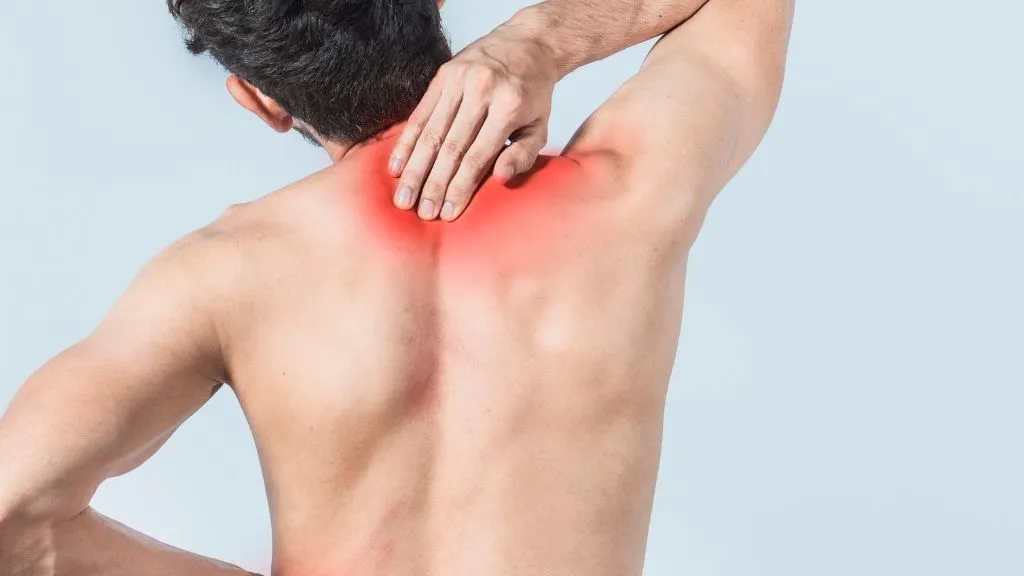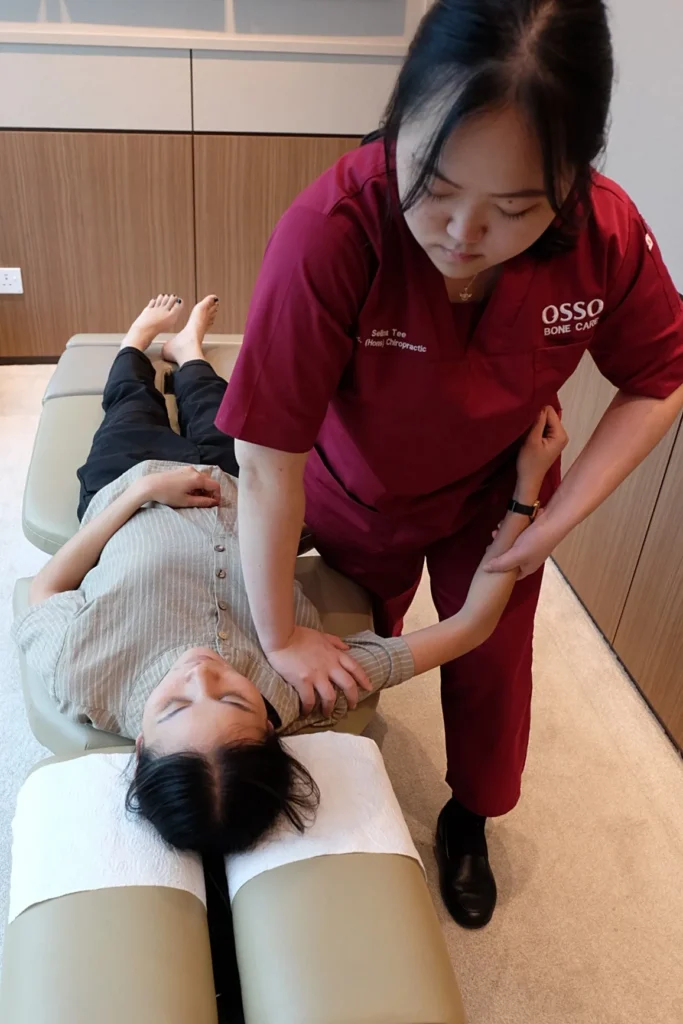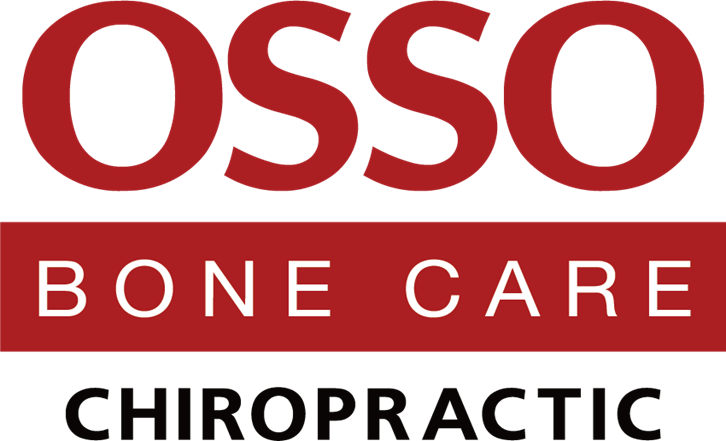Why Neck Pain Causes Numbness or Tingling in Your Arm, and What to Do?
Ever wake up with a stiff neck and then feel tingling down to your arm?
Maybe you slept in the wrong position? scrolled your phone too long? or carried something heavy the day before? But if you’ve ever felt numbness, tingling, or even a weird “electric” sensation running from your neck down into your shoulder, arm, or fingers, your body may be telling you something important.
That annoying buzz in your arm might actually be starting at the source: your neck. Why is it happening and what can you do to the numbness and tingling feeling?
How Pinched Nerves in the Neck Affect Your Arm

Your cervical spine (that’s the top part, in your neck) contains nerve roots that exit between each vertebra and travel down into your shoulders, arms, hands, and fingers.
Now, if something disrupts that signal like a bulging disc or a joint out of alignment—those nerves get compressed. And when nerves get irritated, they send strange signals: pain, tingling, numbness, or even weakness in your arm or hand.
It’s not that there’s a problem in your arm; it’s that the nerve serving your arm is being pinched at the source, which is your neck.
This type of nerve compression is often called cervical radiculopathy, and it’s more common than most people think. This is especially for people with poor posture, degenerative disc issues, or those who spend long hours on phone, laptop or PC.
So yes. A problem in your neck can absolutely cause symptoms in your arm.
Common Causes of Neck-Related Arm Symptoms
Several conditions can lead to this type of nerve compression in the neck:
Cervical Disc Herniation (Slipped Disc)
A disc herniates when the inner jelly (nucleus pulposus) pushes out through a crack in the outer layer. If that bulge touches or compresses a nerve root, it can trigger sharp, radiating pain down your arm, tingling, or even numbness.
Degenerative Disc Disease (DDD)
Discs begin to lose hydration, height, and flexibility, shrinking down like worn-out cushions. This reduces the space between vertebrae and can narrow the nerve openings, increasing the risk of compression.
Poor Posture or “Text Neck”

If you spend hours hunched over your phone or laptop, looking down repeatedly strains the natural curve of the neck. In fact, leaning your head just 2–3 inches forward can triple the load on your neck muscles and joints.
Over time, this strain can cause the vertebrae to shift slightly, irritating nearby nerves especially around the C5 to C7 levels, which are responsible for arm and hand function.
Cervical Arthritis or Bone Spur
Wear-and-tear arthritis in the neck, or cervical spondylosis, can cause inflammation and the growth of bone spurs. Bone spurs are small bony projections your body creates in response to joint stress. These bone spurs can narrow the space where nerves exit the spine and lead to compression.
Sudden Injuries or Whiplash
Even a “minor” car accident or fall can cause whiplash, where the neck snaps forward and backward quickly, stretching or tearing ligaments and soft tissues. This trauma may cause inflammation, muscle spasms, or slight vertebral misalignment—all of which can irritate nearby nerves.
Not all nerve issues come from dramatic injuries. In fact, long-term microtrauma like years of desk work, bad ergonomics, or heavy backpacks can quietly build up until one day your neck locks up and your hand goes numb.
Warning Signs of Developing Neck Pain You Shouldn’t Ignore

1. Pain That Starts in the Neck and Travels Downward
This kind of pain doesn’t just stay in the neck. It often spreads or radiates into the shoulder, down the upper arm, and even to the fingers. This is a classic sign of nerve root irritation, especially if the discomfort follows a clear line down your arm.
2. Tingling or “Pins and Needles” in Your Hand or Fingers
If you feel tingling that comes and goes or is brought on by certain movements (like tilting your head), there’s a good chance a cervical nerve is being compressed or irritated.
Different fingers affected can also hint at which nerve root is involved. For example:
- Tingling in the thumb and index finger? Possibly the “C6 nerve root”
- Tingling in the middle fingers? Could be the “C7 nerve root”
3. Numbness in Specific Parts of the Arm
Numbness means the nerve is not just irritated, it may be losing function. It often starts subtly but can become more noticeable with time. If you can’t feel part of your forearm, or you notice patches of skin that feel “dead” to touch, don’t brush it off.
4. Weak Grip Strength or Arm Fatigue
If holding a pen, opening jars, or typing feels harder than it used to, or if your arm gets tired doing everyday things— your motor nerves may be affected. That means the nerve isn’t just sending sensory signals (like touch and temperature), but your muscle strength is being compromised too.
Left untreated, this can lead to muscle atrophy or permanent weakness in the arm or hand. In serious cases, people can even drop objects unexpectedly or struggle to lift their arm above shoulder level.
5. Pain That Worsens With Neck Movement
Neck movements can narrow the spaces where the nerves exit your spine, intensifying any compression. That’s a key sign of mechanical nerve irritation.
If any of these sound familiar, especially if they stick around for more than a few days, then it’s time to get checked out. The longer a nerve stays compressed, the harder it can be to regain full function. That’s why chiropractors recommend a thorough evaluation, especially when symptoms are moving down the arm.
How Chiropractic Treatment Can Help

Flexion-Distraction Technique
Utilizing Osso’s very own Osso Flexion Distraction Adjustment Technique ®, chiropractors employ a specialized method for treating herniated discs through gentle spinal stretching to alleviate pressure on the nerve and spinal disc. Repeatedly flexing the spine opens the gap of the disc to increase space between vertebrae, decrease disc pressure, increase opening for the nerves to relieve pinched nerves.
Unlike surgical interventions, the Flexion-Distraction Technique is a non-invasive procedure, making it a favorable option for many seeking conservative care. This technique holds promise in providing relief for individuals suffering from herniated discs.
Spinal Decompression Therapy
Osso 3D Spinal decompression therapy®, a chiropractic treatment method utilizing advanced computer-controlled traction system that involves stretching the spine gently to create negative pressure, which helps retract herniated disc material. This negative pressure creates a “suction effect” that draws in disc herniation or disc bulges, effectively taking pressure off the “pinched” nerve.
By reducing nerve compression, improving blood flow, and aiding in the healing process of the affected disc, spinal decompression can provide relief. Chiropractors utilize specialized equipment to perform this technique, customizing the treatment to address individual conditions and symptoms effectively, as it is the best alternative before resorting to a surgery.
Research indicates that spinal decompression therapy can be beneficial in decreasing pain and enhancing function in individuals with herniated discs. This non-invasive approach aligns with chiropractic principles of addressing underlying issues contributing to disc herniation, offering a holistic method to manage and treat the condition.
Drop Table Technique
The drop table technique in chiropractic treatment involves a specialized table segment that’s strategically raised and then swiftly dropped during adjustments. This method allows for a gentle and controlled adjustment of the spine to target bulging discs and other spinal issues effectively.
Chiropractors use the drop table technique to pinpoint specific adjustment areas of the spine with accuracy, aiding in the correction of spinal alignment. The controlled dropping motion requires less force, making it a comfortable option for patients experiencing bulging disc. Patients often find the drop table technique to be both comfortable and effective in reducing pain and improving spinal alignment.
Chiropractic care offers spinal adjustments to relieve pressure on the affected disc and promote healing.
Posture Correction & Ergonomic Advice
At Osso, chiropractors don’t just adjust your spine—they work with you to identify posture habits that may be quietly damaging it. That could include:
- Teaching you how to stretch your head, neck, and shoulders during daily activities
- Showing you gentle exercises to strengthen weak postural muscles
- Recommending corrective stretches to release tight areas pulling your spine out of place
We’ll also guide you on how to move smarter, whether it’s lifting groceries or cradling your phone. Because flare-ups often happen when your body goes into default mode, and the default posture, for most people, isn’t great.
Before starting treatment, we perform a digital X-ray to pinpoint the exact spinal level involved. This allows us to tailor the treatment with precision—ensuring it’s both targeted and effective.
When to Seek Help for Numbness from Neck Pain
If the numbness, tingling, or pain lasts longer than a few days (or keeps coming back), don’t wait. These symptoms are signs of an irritated nerve, and the longer it’s compressed, the longer recovery can take. The sooner you get care, the faster and better your recovery will be.
“Don’t ignore the signals your body is sending. Your arm might hurt, but the real problem could be in your neck.”
One of The Best Chiropractic Centers in Malaysia
That tingling in your hand or arm? It’s not just bad circulation or poor sleep posture.
In many cases, it’s a treatable spinal issue that can be improved with the right care. Osso’s experienced chiropractic team is here to help you get back to normal so you can turn your head, lift your arm, and sleep through the night again, comfortably.
Advancing as pioneers in the field since 2007, we are the first chiropractic center in Malaysia to offer integrated digital x-ray services, streamlining your chiropractic care under one roof. Many patients have found success and results with Osso Bone Care due to our unique, signature treatments and by showing evidence of the spinal condition with our Digital X-Ray screening, which accurately diagnoses the root cause of the spinal conditions.
Why Would You Want to Go to a Different Place if OSSO Bone Care Chiropractic® has All That You Need?
